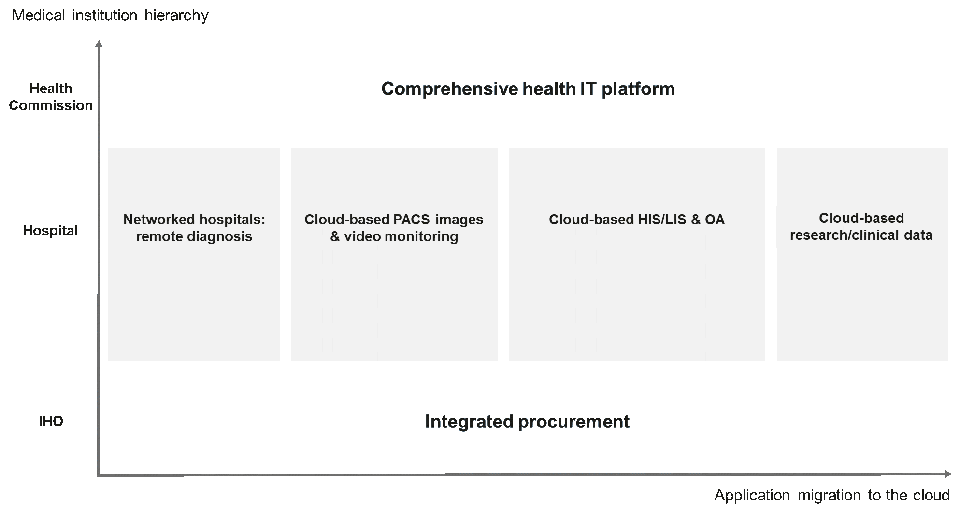Industry Trends
Benefits of Shared Cloud Networks from Healthcare Digitalization
As a pioneer of digitalization, the medical industry has huge market potential. How can carriers leverage Cloud-Network strategies to open up opportunities from healthcare digitalization?


By Lu Libo, Director, Network Marketing & Solution Sales Dept, Huawei Carrier BG

I. Exploring new business models for hospital digitalization in China
China's healthcare industry reform covers three major areas: medicine, health insurance, and medical care. Of these, medical care is relatively easy for carriers to provide digital transformation services for. There are three levels of medical institutions, and the strategies and difficulties for carriers to get involved in the market depend on each level's different requirements.
At the bottom level are integrated healthcare organizations, which include county and township-level hospitals and primary-level clinics. These are led by upper-level hospitals, of which there are now more than 4,000. These organizations belong to an emerging market characterized by limited customization, relatively uniform requirements, strong dependence on government investment, and the small size of individual members. Therefore, independent software vendors (ISVs) are not willing to enter this market.
To digitalize this type of organization, carriers can adopt the "network + cloud + applications" model, with networks playing a primary role. A relatively easy path for carriers is to link and vertically integrate large numbers of organizations.
Medium-level medical institutions include individual hospitals, medical alliances, and specialist alliances in provinces, cities, and counties. These organizations expect extensive customization, have high requirements, and belong to the traditional market. Among them, the top 150 grade-A tertiary hospitals are largely digitalized, and this market is dominated by ISVs. For the digitalization of individual hospitals, carriers can adopt the "application + cloud + network" model, with applications playing a primary role. They can build industry clouds and transform multiple existing private lines into private networks to support legacy LAN demands so as to enhance customer loyalty. The "network + cloud + application" model can be adopted for the digitalization of other ordinary hospitals.
At the top level are authorities such as the National Health Commission, which directly builds and manages the comprehensive health IT platforms and private network projects.

Figure 1: China's healthcare digitalization progress and needs
Carriers can deploy different solutions to address the above scenarios.
1. Top grade-A tertiary hospitals: Vertical integration that leverages applications and industry clouds
It is not easy for carriers to develop digitalization projects with top grade-A tertiary hospitals. First, top tier-3 hospitals have strong ICT capabilities and well-established IT systems. They can be digitalized quickly, and most of their fservices are provided by ISVs. Second, these ISVs deeply understand the pain points of hospitals and meet their customized needs for functionality and experience through application iteration. Third, although these hospitals invest heavily in digitalization, connectivity normally accounts for no more than 10% of investment. Therefore, carriers typically only provide resources such as private lines and equipment rooms, and their role is often one of being integrated.
To address this passive situation, carriers can seize the opportunity of application migration to the industry cloud by first focusing on fostering cloud+network services with a small number of customers, and then promoting them to more hospitals.
For example, in the digitalization project of a hospital in Guizhou Province, the hospital migrated the picture archiving and communication system (PACS) to the cloud between 2019 and 2020 to meet the classified protection compliance requirements of the Health Commission. The carrier worked with two PACS partners to provide cloud+network services for the hospital and other medical alliance members. The carrier also heeded the specifications of Guizhou Province Development and Reform Commission for a charging standard for the PACS imaging service and worked with ecosystem partners to jointly develop users through a revenue-sharing model. This model reduced the cost of using films in the radiology department and for expanding PACS storage capacity, while shortening waiting time for patients, giving them easy access to images for telemedicine and hospital transfer.
2. General tertiary hospitals: Focusing on localized "cloud + network + security" solutions as general integrators of digital infrastructure
The IT departments of general tertiary hospitals used to be effective in supporting hospital digitalization. However, the explosion in digital services is placing an increasing burden on IT departments. Therefore, hospitals began to raise demands for localized and specialized cloud+network services, which provided a window of opportunity for carriers to serve as general integrators.
For example, the largest grade-A tertiary hospital in a city in Shanxi Province has established a full set of IT systems, including a hospital IT network and integrated medical big data platform. The hospital's current digitalization project aims to build a dedicated cloud platform and make the hospital intelligent over the next five years. This requires security in five areas: cloud, cybersecurity, data, the core hospital network, and the migration process. The hospital chose a carrier rather than an ISV or public cloud vendor to implement the project. There were a few reasons for this choice:
1) In general prefecture-level cities, grade-A tertiary hospitals withwell-established IT systems are weakly covered by ISVs and public cloud vendors, whereas carriers have B2B key account managers and industry solution development teams, with advantages in providing localized pre-sales, in-sales, and post-sales services.
2) In general tertiary hospitals, existing digital talent cannot meet the needs of rapidly growing digital services. Given insufficient onsite ISV employees, the local self-construction and self-maintenance model no longer applies. With the development of intelligent hospitals, hospital networks, platform upgrades and cloud migration are urgently needed. These are exemplified by insufficient local equipment room space, high usage of hardware resources like servers, difficult integration and elasticity of hardware, and O&M workloads that increase by five to ten times to the virtualization and complexity of software. Hospital IT staff are increasingly overwhelmed.
3) Carriers provide localized, ubiquitously secure, integrated cloud-network-security solutions based on premium private lines to meet hospital needs for reliability assurance and the security isolation of important services. Carriers' cloud private line, network slicing, and graded protection solutions ensure end-to-end data reliability and security. Carriers' localized two-city, three-DC geo-redundancy and disaster recovery solutions developed in collaboration with specialized partners are highly regarded. Carriers also provide solutions such as three-route protection and single-node-free processes to ensure uncompromised total bandwidth and latency, even when individual routers are faulty.
4) Leasing rather than building the hospital network enables shared success. Hospitals only need to purchase services for the dedicated cloud platform, in-hospital core switches, and firewalls, greatly reducing the costs and burden of digital infrastructure planning, construction, and O&M. For carriers, connectivity accounts for a larger proportion of investment, making it easier for them to serve as general integrators.
3. IHOs and secondary hospitals: Building a digital infrastructure platform
Carriers are clearly more competitive in IHO digitalization projects. First, ISVs and public cloud vendors have limited involvement and investment in this market for a number of reasons, including the limited investment in digitalization and the standardized medical application requirements of county- and township-level hospitals. Second, IHOs have strict requirements on the reliability and security isolation of core services. Third, connectivity accounts for up to 30% of investment of IHO digitalization projects, making it easy for carriers to serve as general integrators. Therefore, carriers can build digital infrastructure platforms by focusing on localization.
As a pilot region for China's healthcare reform, Ningxia Province launched a county-level healthcare reform pilot project in 2019, aiming to develop a shared and unified digital IHO platform as the underlying infrastructure for the various IT systems of IHO members. In the future, township hospitals and community health service centers will be equivalent to departments of the municipal people's hospital, with whom medical resources will be shared, collaborative diagnosis performed, and electronic medical records acquired remotely. Patients will no longer have to go through repeated registration. They will be able to obtain prescriptions through teleconsultations, and receive examinations and pick up medicines locally. An IHO in Ningxia consists of a secondary hospital and more than a dozen community and township hospitals. The IHO's digital infrastructure project involves equipment room upgrades, network migration, cloud private lines, and cloud resources. One carrier won the bid exclusively.
Many secondary hospitals are IHO leaders. For example, the largest county-level secondary hospital in Anhui Province is both a member of a close medical alliance led by a municipal-level hospital and the leader of an IHO joined by ten township health centers. This hospital is a crucial part of the carrier's efforts to promote IHO digitalization. However, the digitalization progress of different IHO members varies greatly, which means the digitalization project of this hospital is more suitable for individual development beyond the IHO.
II. Practices of carriers outside China: Cloud-based access and connecting the unconnected
Globally, carriers are also making strategic adjustments and exploring opportunities in healthcare digitalization. The healthcare industry varies by region, and digitalization progress varies greatly. Healthcare digitalization projects around the world are using unique business models. Two examples are given below:
1. Renowned private hospital: Infrastructure-based vertical integration
Healthcare digitalization in some Southeast Asian countries, such as Malaysia and Thailand, are similar to China in terms of progress and projects. In February 2021, the Malaysian government proposed the Malaysian Digital Economy Blueprint (MyDIGITAL) to boost the country's digital transformation. This blueprint involves a cloud-first strategy, with 80% of public data migrated to the cloud by the end of 2022. A leading carrier in the country is playing a crucial role in implementing this national cloud strategy and digital infrastructure construction.
A renowned private healthcare hospital in Malaysia has the typical need for migrating its hospital information system (HIS) to cloud, while also requiring better value-added digital services, including data security, storage and backup, reliability assurance, and disaster recovery. The hospital's IT department also expects their O&M burden to be reduced through asset-light operations and one-stop services.
Similar to the example of the grade-A tertiary hospital in Shanxi, China, thehospital in Malaysia has also chosen a leading carrier to undertake its digitalization project. There are three reasons for this choice: First, the partnership is well-established, as the carrier has provided private line services for hospitals for a long time. Second, the carrier is constructing Malaysia's sovereign cloud, so it is the preferred choice for supporting the cloud migration of public health data. Third, the carrier's localized, integrated cloud-network-security solution meets the hospital's needs.
2. Hospitals in the initial stages of digitalization: Connecting the unconnected with cross-border cloud resources
In countries like Uganda and Pakistan, where healthcare digitalization is still in its early stages, many hospitals are yet to be informatized and still rely on paper to share medical information. However, carriers still have business opportunities in these markets. They can focus on strengthening connectivity, improving telecom infrastructure, and leveraging cross-border cloud resources.
For example, Uganda's healthcare industry is in the process of being informatized, with about 300 hospitals covering only half of all households capital city. The COVID-19 pandemic has boosted the country's need for healthcare digitalization, including connectivity coverage, fast provisioning, service visibility and assurance, and simplified O&M.
Against a blue ocean of industry digitalization, one Ugandan carrier is adopting a new strategy and embracing cloud transformation. On the network side, the carrier is using private lines to connect more hospitals and provide a visible and guaranteed private line experience for hospitals. It also provides differentiated services for typical use cases such as hospital interconnections, remote consultation, video monitoring, and online skills training, giving more homes and remoter areas access to medical resources through networks. On the cloud side, as Uganda does not yet have public cloud resources and carriers cannot yet deploy their own clouds, the carrier is taking advantage of its cross-border network, leveraging cross-border cloud resources and multi-cloud interconnection services planned by the group.
The development of healthcare digitalization projects requires both strategic determination and investment, as well as new mindsets and approaches. While exploring business opportunities, carriers must gain deep insights into industry needs, quickly develop solutions, and define appropriate business models. Huawei will work with carriers to innovate and grow, and support carriers in upgrading and deploying cloud and networks. The collaboration between carriers and Huawei will help the healthcare industry realize data-driven, intelligent operations, and enable carriers to develop a competitive edge in the market and share the benefits of cloud and networks.






